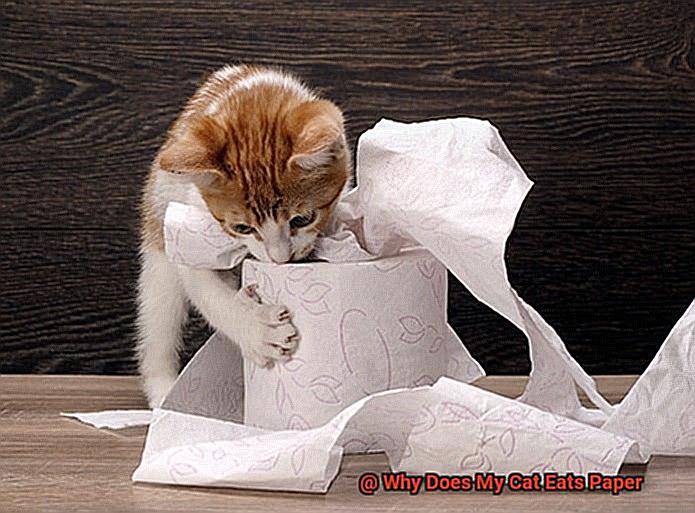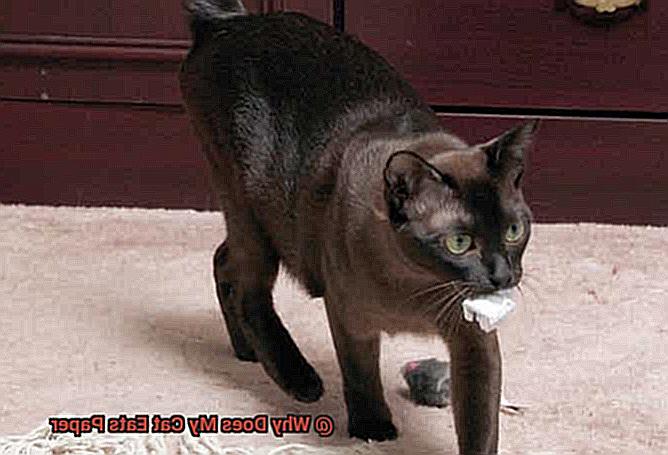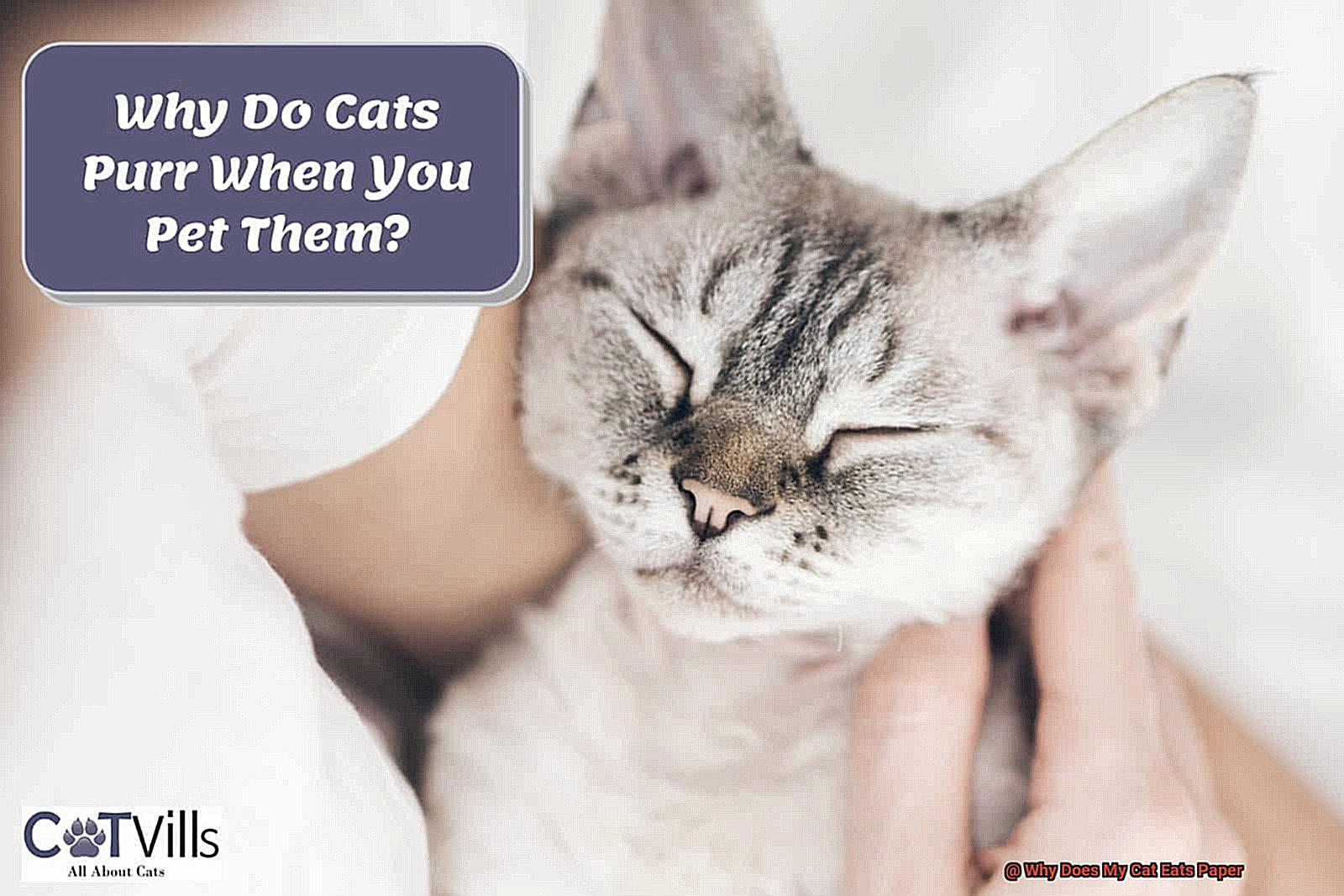Have you ever asked yourself why your cat loves to eat paper? It can be perplexing, but there are actually several reasons why cats may be drawn to paper products. From boredom to curiosity, cats are known to munch on paper for a variety of reasons. In this blog post, we’ll explore why cats eat paper and what we can do about it.
It’s important to note that eating paper isn’t usually a health risk for your cat. However, if they start ingesting large amounts of it, digestive problems may occur.
So, why does your cat eat paper? Boredom is often the culprit; if your cat doesn’t have enough stimulating activities or toys around the house, they may turn to newspapers as a source of entertainment. Cats also like foods that smell like food, so if you have food wrappers lying around, they may be tempted to take a bite out of them. Additionally, some cats simply love the texture of paper – making it exciting to crunch on.
Furthermore, some cats may opt for eating paper out of boredom or anxiety. If something in their environment has changed recently or they feel unsafe or anxious in any way, they may start looking for new things to explore and play with – including pieces of paper.
If your cat is consuming too much paper, there are steps you can take to try and reduce the behavior. Make sure your cat has plenty of toys and other household items that will keep them entertained; invest in interactive toys that reward them with treats when they complete certain tasks.
Additionally, store all food wrappers properly so your pet won’t be tempted by any smells emanating from them. Finally, consult with your veterinarian about potential stress-reducing drugs or supplements that may help reduce anxiety in your dog.
So, although it may seem strange at first that cats eat paper goods, there are actually several potential explanations for this behavior.
By understanding the root causes of this behavior and taking steps to address it appropriately you can protect both you and your pet from any potential health risks associated with eating too much paper.
What is Pica?
Cats may be suffering from Pica – a condition that causes cats to crave and ingest non-food items. This disorder is more common among kittens and younger cats, but can also affect older felines. Left untreated, Pica can lead to serious health complications such as intestinal blockages, vomiting, diarrhea and malnutrition.
If you suspect your cat has Pica, it’s essential to take them to the vet for an examination. Your veterinarian can order diagnostic tests such as bloodwork or X-rays to rule out any underlying medical conditions that may be causing the behavior. They may also recommend behavioral modifications or medications to help manage the condition.

In addition to seeking professional assistance, there are also some things you can do at home to help reduce your cat’s pica habits. Providing them with plenty of toys and playtime will help redirect their chewing behavior and keep them entertained.
Making sure their diet contains sufficient amounts of fiber is also important in keeping them healthy and happy.
Causes of Pica in Cats
While it may seem peculiar among cats, it is not unheard of. Pica is a medical disorder that can be triggered by a variety of factors.
Nutritional deficiencies
Nutritional deficiencies can be one cause of Pica in cats. Cats may crave certain minerals or nutrients that they are not getting in their diet, such as fiber, iron, zinc, and other minerals. Thus, they may consume non-food items to increase their intake of these nutrients.
Psychological issues
Pica may also be related to psychological issues such as stress, anxiety, or boredom. Some cats may resort to eating paper or other materials as a coping mechanism for anxiety or stress. Similarly, cats who are bored may chew on paper or other items to entertain themselves.
Medical conditions
Certain medical conditions can also contribute to Pica in cats. Hyperthyroidism, gastrointestinal diseases, dental problems, and other medical conditions can lead to a lack of appetite and cause cats to seek alternative sources of nutrition.
It is important to note that Pica can be dangerous for cats and can lead to intestinal blockages, vomiting, diarrhea and even choking if left untreated. If you notice any signs of Pica in your cat – including eating paper or other non-food items – it is essential that you contact your veterinarian immediately for proper diagnosis and treatment.
Lack of Fiber in Diet
If your kitty has been snacking on paper or other non-edible items, it could be a sign of pica, a disorder caused by various conditions such as stress, boredom, anxiety and anemia. However, one of the most common causes of pica is a lack of fiber in the cat’s diet.
Fiber is essential for cats to maintain their digestive health. It helps promote beneficial gut bacteria, regulates bowel movements and prevents constipation. If cats are not getting enough fiber in their diet, they may start eating paper to make up for the deficiency.
This is often seen when cats are fed a predominantly meat diet or low-quality commercial food that lacks sufficient fiber.
To ensure your cat’s diet is high in fiber, feed them high-quality commercial food designed specifically for feline digestion. You can also add canned pumpkin or cooked vegetables to their meals for an extra nutritional boost.
If your cat continues to eat paper despite having a balanced diet, consult your veterinarian to rule out any underlying medical conditions that may be causing this behavior.
Make sure your furry friend gets all the nutrition they need.
Cat Curiosity
While it may appear harmless, it could be a sign of something more serious. Cats are known for their curiosity, and this can sometimes lead them to do things that seem strange or even dangerous. Many cat owners are worried and confused by their cats eating paper, but why do cats eat newspaper?
The answer lies in their natural instincts and behaviours. Cats are hunters by nature, and they can view paper or cardboard as potential prey. The texture and shape of these materials can mimic the movements of small animals, which can trigger a cat’s natural hunting instincts.
Additionally, cats may be attracted to the scent of ink or glue that is often found in paper products.
In some cases, cats may also have a condition called pica which is characterized by the consumption of non-food items such as paper, plastic, or fabrics. Stress, anxiety, boredom, or nutritional deficiencies can all cause pica. In some instances, cats may resort to eating paper to cope with anxiety or stress – it provides them with a feeling of comfort and security.
Although eating paper may not seem harmful at first glance, if left unchecked it can actually be very dangerous for cats. Ingesting large amounts of paper or cardboard can cause gastrointestinal blockages which can be life-threatening if left untreated.
Additionally, some paper products may contain chemicals or toxins that can be hazardous to cats if ingested.
Potential Health Risks
Ingesting paper can cause intestinal blockages, which occur when pieces of paper get stuck in the intestines and prevent food from passing through the digestive tract.
Symptoms that could indicate your cat has ingested paper include vomiting, diarrhea, abdominal pain, constipation, lethargy, and loss of appetite; if left untreated these symptoms can quickly escalate to dehydration, weight loss and even death.
In addition to blockages, ingesting paper products can also introduce harmful chemicals into your cat’s system. Receipts and other paper products may contain BPA and other dangerous contaminants that are toxic when consumed in large amounts.
To protect your cat from potential health risks associated with eating paper, it is important to keep all paper products out of reach and provide your feline companion with enough toys and entertainment to avoid boredom which could lead to destructive habits such as chewing on paper.
If you suspect that your cat has eaten any kind of paper product or is displaying any concerning signs or symptoms such as vomiting or diarrhea, contact your veterinarian immediately for advice and care.
Diagnosing the Cause
Are you noticing pieces of paper scattered around your home and suspecting your cat may be the culprit? If so, we understand how frustrating this can be. Cats have been known to engage in some peculiar habits, one of which is eating paper. Here is a guide to diagnosing the cause of why your cat eats paper and how to prevent it.
The first step in determining why cats eat paper is to identify any underlying medical issues. Cats may eat paper due to pica, a condition characterized by non-food consumption.

Anemia, parasites, or digestive disorders can all cause pica, so it’s important to take your cat to the vet for a thorough examination if you think this could be the issue. Your vet will be able to provide you with the best advice and guidance based on your cat’s individual needs.
Behavioral problems can also result in cats eating paper. Boredom, anxiety, and stress can all contribute to destructive behaviors such as chewing or eating paper. Consider environmental enrichment activities such as providing interactive toys or puzzles to keep them physically stimulated.
In addition, pheromone therapy or behavior modification techniques may help address any underlying behavioral issues that could be causing your cat’s participation in this behavior.

Lastly, dietary deficiencies or an inadequate diet may also be causing your cat to eat paper. A balanced and nutritious diet is essential for a cat’s overall health and well-being; make sure you provide them with nutrient-rich foods that meet their dietary requirements.
If necessary, consult with your veterinarian to find out what kind of diet will best suit their needs.
Treatment and Prevention Strategies
While it may seem like an odd behavior, it’s not uncommon. In fact, cats can eat paper for a variety of reasons. To understand the causes and treatment strategies for cats that eat paper, let’s take a closer look.
In some cases, cats may develop a condition called pica, which is characterized by eating non-food items such as paper, plastic or fabric. This could be caused by boredom, fear or anemia and it’s important to take your cat to the vet to rule out any underlying health issues.
Cats may also be drawn to paper due to a lack of fiber in their diet. Fiber is essential for digestion and general wellbeing so if your cat isn’t getting enough fiber from their diet they may resort to eating paper as an alternative source. The solution is simple
provide your cat with a balanced and nutritious diet that meets all of their nutritional needs.
Finally, cats may also eat paper simply out of curiosity – the texture, smell or taste may be too tempting.
If your cat is otherwise healthy and not showing any other abnormal behaviors this isn’t necessarily concerning but it’s still important to ensure they aren’t consuming excessive amounts of paper as this could lead to potential health issues.
Conclusion
In conclusion, it’s important to understand why cats eat paper and the potential dangers it can pose. Heavy paper intake can lead to serious health issues such as intestinal blockages, vomiting, and diarrhea.
Potential causes include boredom, anxiety, nutritional deficiencies, and medical disorders like pica. To discourage your cat from eating paper, provide them with interactive toys that reward them with treats.
Additionally, store all food wrappers properly so your cat won’t be tempted by any scents coming from them. If you suspect a medical condition or other signs or behaviors indicating pica or stress/anxiety, consult with your veterinarian for the right treatment and care.







